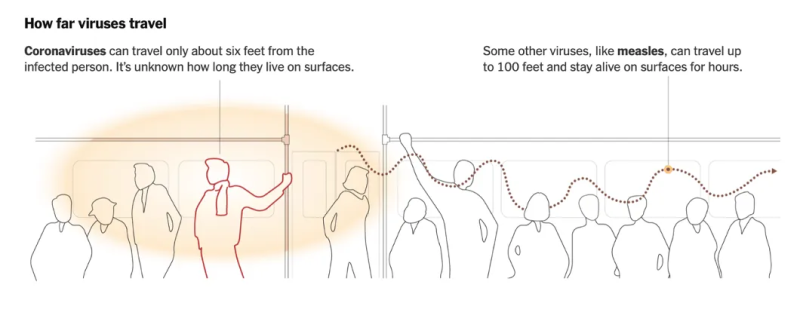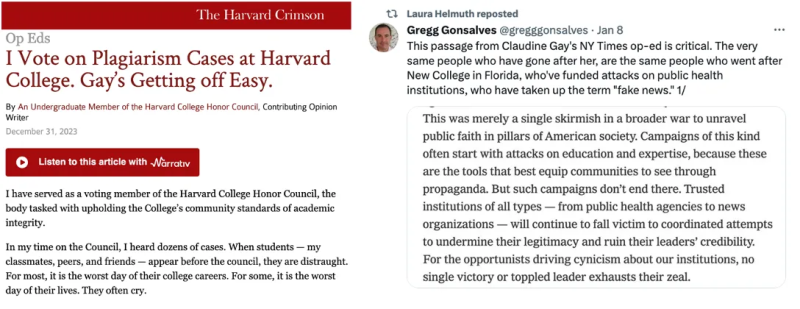
Former White House medical adviser Dr. Anthony Fauci admitted in a congressional deposition last week that the federal government’s Covid guidance for six-feet social distancing was not based on scientific evidence, stating under oath “it sort of just appeared.” Fauci’s testimony came during the second day of his closed-door deposition before the House Select Subcommittee on the Coronavirus Pandemic, and echoed a similar comment made by former FDA Commissioner Dr. Scott Gottlieb.
“The six feet rule was arbitrary in and of itself,” Dr. Gottlieb said during a September 2021 appearance on “Face the Nation” while discussing Covid guidance. “Nobody knows where it came from. The six feet is a perfect example of sort of the lack of rigor of how CDC made recommendations.”
Curious to see who had promoted this arbitrary rule that “sort of just appeared,” I began searching news articles and social media and ran across an expert declaration on Yale’s website, filed by Gregg Gonsalves with the School of Public Health and Yale Law School. Gonsalves also writes regularly for multiple media outlets, including the Nation where he is their public health correspondent. “Data from China indicates that the average infected person passes the virus on to 2-3 other people at distances of 3-6 feet,” Gonsalves claimed in a legal filing.
Every Medical Crisis is AIDS
In case you’re unaware of Gregg Gonsalves, he’s a 1980s AIDS activist who later in life attended university and then, for some reason, got hired by Yale. But having honed his talents in advocacy, he retains a street activist’s indifference for scholarship and a pugnacious skill in diagnosing every medical crisis as AIDS in the 1980s.
1980s Flashback:
Ebola? That’s AIDS, Gonsalves told NPR.
Opioid epidemic? AIDS again, he told the New York Times.
How about Monkeypox? Do you need to read this Gregg Gonsalves essay, or is the evidence not clear? Hello, it’s AIDS!
And when the Covid outbreak began, physicians scrambled to study a never before seen virus, struggled to understand how it spread, and argued over how to best stop it.
Meanwhile, Gonsalves offered up another 1980s flashback performance. Can you hear Madonna pumping in the background? Papa Don’t Preach: it’s AIDS all over again.
Speaking to Vox, Gonsalves explained that “Trump’s handling of the crisis feels like an eerie callback to the 1980s, when then-President Ronald Reagan chose to ignore early warnings about the threat from HIV/AIDS.”
With Trump now posing as Reagan with a bad tan and orange hair, Gonsalves then donned a white coat and prescribed a New York Times article as treatment to manage a respiratory virus that had nothing to do with HIV. “Unless we figure out how to sort of move toward what the New York Times called for the other day — a national lockdown of sorts,” Gonsalves told Vox, “We’re just going to see cases increase and emergency rooms and ICUs across the country be filled to capacity.”
On social media, Gonsalves continued arguing for lockdowns, before complaining that he was being mischaracterized as pro-lockdown. And then cycling through this flip-flop once again.
It’s the logical consistency of a small-minded hobgoblin.

Which brings me back to Fauci and the “it just sort of appeared” science for six-feet social distancing.
Protestors Don’t Need Data
In a March 2020 expert declaration under penalty of perjury, Gonsalves claimed, “Data from China indicates that the average infected person passes the virus on to 2-3 other people at distances of 3-6 feet.” The declaration apparently supported legal claims that prisoners were at risk of Covid injury and should be released from the hoosegow.
But if you examine Gonsalves’ writing carefully (apparently, he didn’t) you’ll see he cites medical support for his 3-6 feet claim with footnote #7.

But when you go to footnote #7, you find Gonsalves doesn’t cite actual medical evidence; Just as when he argued for lockdowns in Vox, Gonsalves’ medical proof is a news story in the New York Times.

Perhaps you’re unfamiliar with science and how experts rank research, but nowhere in the medical literature do you find “newspaper article” cited as credible evidence. Please see this explanation at Mt. Sinai Medical School, if still in doubt.
But it gets even more odd.
When you read the New York Times article, you find there is no “data from China” as Gonsalves claims. The only proof the newspaper article provides for “six feet social distancing” is—get this—an artist’s drawing.

In short, Yale’s Gregg Gonsalves filed a legal declaration that made a medical claim based on a newspaper article—and that newspaper article doesn’t contain any evidence as Gonsalves claims.
Quite the expert, no?
To understand how this meets Yale’s academic standards, I emailed Gonsalves, asking him to explain. Because Gonsalves has a long history of haranguing reporters, such as the New York Times David Leonhardt, I asked him to explain that as well.

Here are the questions I sent Gonsalves:
- Do you normally cite newspaper articles to make medical claims either in peer-reviewed journal articles or legal filings? Or is this an exception?
- Are you being paid to file legal declarations in these lawsuits? If yes, what is your hourly billable and what percentage of your academic time does this take up?
- What specifically is your problem with reporters? You spend an inordinate amount of time on social media policing them.
- Anything you would like to add?
Despite multiple requests for comment, Gonsalves refused to explain.
Social Media Street Activist
Some months after Gonsalves made his scientifically unsupported claim in a legal filing, reporter David Zweig wrote for Wired pointing out that much of the official Covid guidance came out of nowhere and was not based on science. This meant governments were failing to protect people.
Yet unsourced rules are everywhere in this pandemic. There was no way for the general public to know, at first, that the recommendation to stay 6 feet apart originated in part from a 3-foot rule determined by decades-old studies of card-game players, and that the recommended spacing had been doubled on the basis of research into the spread of the original SARS virus through airplane cabins.
Zweig’s “6 feet apart” link in Wired takes you to an article in Quartz whose reporter also tried to run down the origin of the CDC’s 6-feet guideline “but after multiple attempts over two weeks, the agency failed to comment.”
Whether getting bested by reporters is what drives Gonsalves’ harassment of journalists, I can’t say. Again, he seems incapable of responding to questions.
But in the pandemic’s third year, Zweig wrote an essay for the Boston Globe criticizing a campaign to cancel a talk at the American Public Health Association by Dr. Leana Wen, a frequent Gregg Gonsalves target on social media, and a CNN medical analyst and professor of health policy at George Washington University.
“Public health has a history of healthy dialogue and disagreement,” the American Public Health Association said of the attempt to cancel Dr. Wen’s talk. “We value vigorous debate about public health and support a respectful and fact-based discussion.”
After the Globe published Zweig’s essay, Gonsalves responded in support of a respectful and fact-based discussion by writing, “David Zweig is ghoulish.”

But it’s not just Dr. Wen. Never shying from bullying physicians trying to treat their patients, Gonsalves has also obsessed over Dr. Lucy McBride, a doctor who began writing for the Atlantic and the Washington Post about the harms caused to her patients by C polovidicies, before appearing on CNN, NPR, and MSNBC.
Gonsalves is not a physician—does not see patients—but responded with a series of inflammatory tweets about Dr. McBride. Many of them have been deleted, but one of them is below.

Research has found that trust in scientists has dropped since the pandemic started and distrust has grown—about a quarter of Americans now say they have little or no confidence in scientists to act in the public’s interest. For researchers in academia, public trust is even worse as American confidence in higher education has fallen sharply, Gallup finds. This decline will likely continue.
After Harvard president Claudine Gay was caught plagiarizing, several hundred professors across the nation came to her defense, even as a student on the Harvard College Honor Council wrote in the student newspaper that Gay was being held to a lower standard than Harvard’s own students.
“There is one standard for me and my peers and another, much lower standard for our University’s president,” the student wrote in the Harvard Crimson. “The Corporation should resolve the double standard by demanding her resignation.”
A week later, Gonsalves dismissed Gay plagiarism and launched into a rant, claiming her copy/paste scandal was all about politics.

We can’t fix everything to restore trust in science and public health, but shouldn’t Yale make some tentative first steps?
Republished from the author’s Substack
Disclaimer
Some of the posts we share are controversial and we do not necessarily agree with them in the whole extend. Sometimes we agree with the content or part of it but we do not agree with the narration or language. Nevertheless we find them somehow interesting, valuable and/or informative or we share them, because we strongly believe in freedom of speech, free press and journalism. We strongly encourage you to have a critical approach to all the content, do your own research and analysis to build your own opinion.
We would be glad to have your feedback.
Source: Brownstone Institute Read the original article here: https://brownstone.org/


